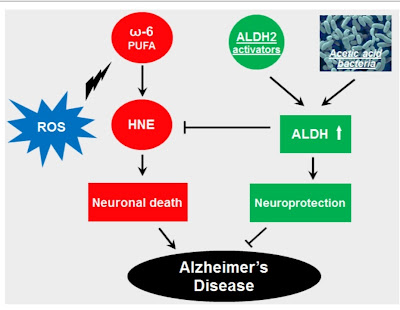Aldehydes from cooking oils as causes of Alzheimer's disease (and obesity)?
We already know aldehydes, they are poisons that arise from polyunsaturated oils either at high temperature (frying) or by (per)oxidation. The best known such substances are MDA (malondialdehyde) or HNE (4-hydroxy-2-nonenal). If we follow up on the previous post, oxalates from plant products such as spinach, beet, but also almond milk or sweet potatoes create an oxidizing environment in blood vessels with increased production of superoxide, thus perfectly supporting the oxidation of linoleic acid from table oils and other polyunsaturated acids, which themselves promote excessive production of hydrogen peroxide in peroxisomes. It is therefore a very dangerous combination of foods for blood vessels, it increases the oxidation of LDL and the formation of atherosclerosis and vascular plaque. Studies show us that HNE also causes vascular muscle hypertrophy, increasing pulmonary blood pressure and pulmonary fibrosis.
 |
| There are drugs containing substances that increase the activity of the ALDH2 enzyme, i.e. they increase the breakdown of HNE, e.g. Alda-1 or the common throat pain reliever Flurbiprofen. |
What can be done to lower HNE levels? For example, we can support the breakdown of aldehydes. One of the main enzymes that determine the rate of aldehyde degradation is the mitochondrial enzyme ALDH2. It is an enzyme that also participates in the breakdown of alcohol. If we constantly burden this route by breaking down a large amount of aldehydes created from alcohol, we will limit the breaking down of more complex aldehydes such as HNE from omega-6 oils. However, a small stimulation of ALDH2 activity by small amounts of alcohol may be beneficial. In small amounts, ozone also has stimulating effects and reduces the level of aldehydes. We even have drugs that activate ALDH2. There is not enough information yet if this is the right way. But we have known for a long time that the easiest way to reduce the body's burden of HNE poison is simply not to consume omega-6 vegetable oils. HNE has one more unpleasant property, it attaches to enzymes and prevents them from working. The increased level therefore slows down the activity of ALDH2 and thus further slows down the breakdown of HNE. This will cause chronic problems. So now you know why to avoid omega-6 oils?
Check out an older study from 1966 that shows the dynamics of change in adipose tissue composition after switching to increased linoleic acid in the diet. With a fat content of 40% in the diet, there was a targeted change in the content of linoleic acid in the fat in the food from 10% to 40%. So the total energy value of omega-6 was first 4% of calories and was changed to 16%. This study would be difficult to carry out today, because we normally consume about 10% of calories in the form of linoleic acid. What can be clearly seen here are slow changes, difficult to observe by an individual. We don't recognize health changes in time and we don't have a chance to discover the causes of health problems in a diet change made long ago.
 |
| Dietary fat composition before and after diet change. The main change is in the increased content of omega-6 (18:2), which over time will affect the level of HNE. |
Obesity can be caused by aldehydes from spontaneous oxidation of polyunsaturated fats (hypothesis):
Aldehydes formed by spontaneous oxidation of polyunsaturated fats are probably also the trigger of pseudohypoxia in adipose tissue. Degradation of polyunsaturated fats produces MDA (malondialdehyde). If the cell converts this dialdehyde to a dicarboxylic acid, malonate, it stops SDH (succinate dehydrogenase, mitochondrial complex II), so succinate accumulates. This stops PHD (prolyl hydroxylase) and stabilize HIF-1α. For to suppress the effect of a high-fat diet, it is enough to turn off HIF-1α. This breaks the chain of events and disables the effect of (polyunsaturated) fats in triggering pseudohypoxia via HIF (hypoxia inducible factor) and the fat storage metabolic program is not triggered.
 |
| Aldehydes as secondary products apparently trigger pseudohypoxia (activate HIF-1), which can be inferred from the almost 3-fold increased activity of lactate dehydrogenase (LDH). |
References:
Possible Prevention of Alzheimer’s Disease by Aldehyde Dehydrogenase
ALDH2 Protects Against Hypoxia-Induced Pulmonary Hypertension
Effect of low-dose ethanol on NLRP3 inflammasome in diabetes-induced lung injury
Post-translational modifications of mitochondrial aldehyde dehydrogenase and biomedical implications
Chris Knobbe - 'Diseases of Civilization: Are Seed Oil Excesses the Unifying Mechanism?






Comments
Post a Comment